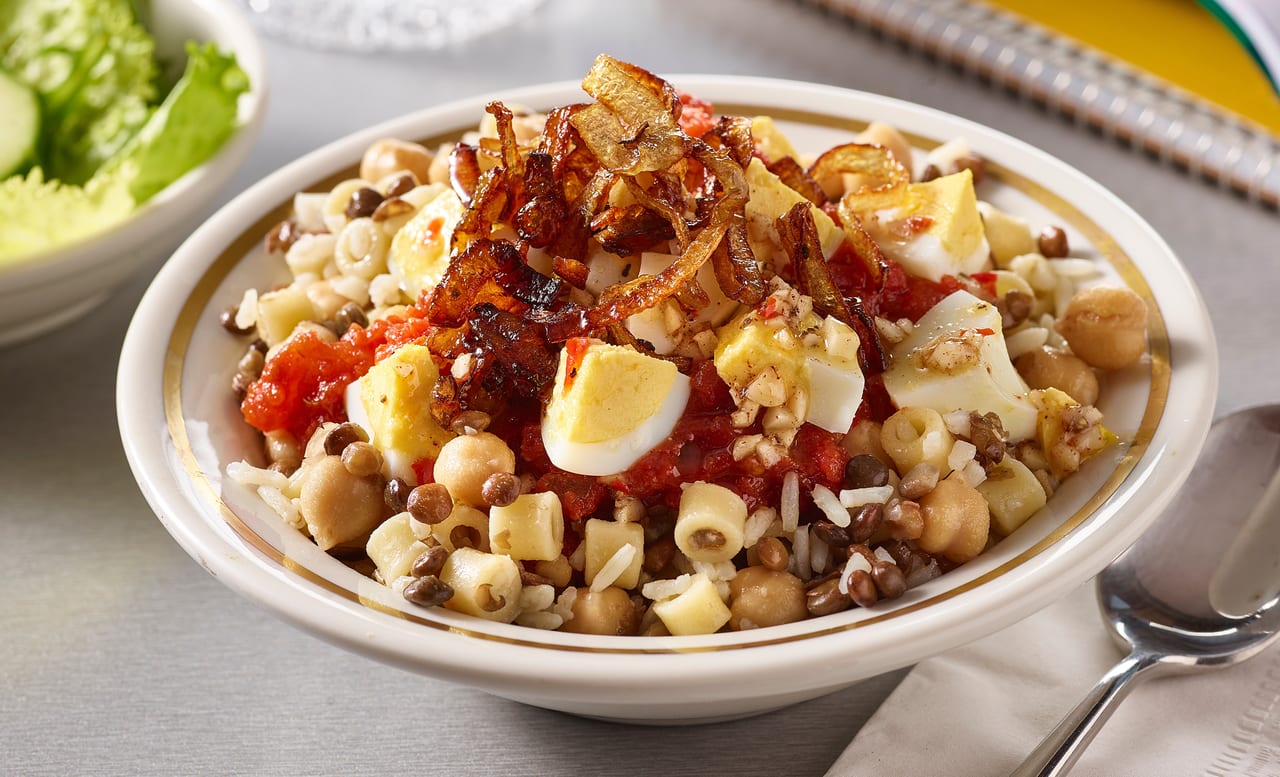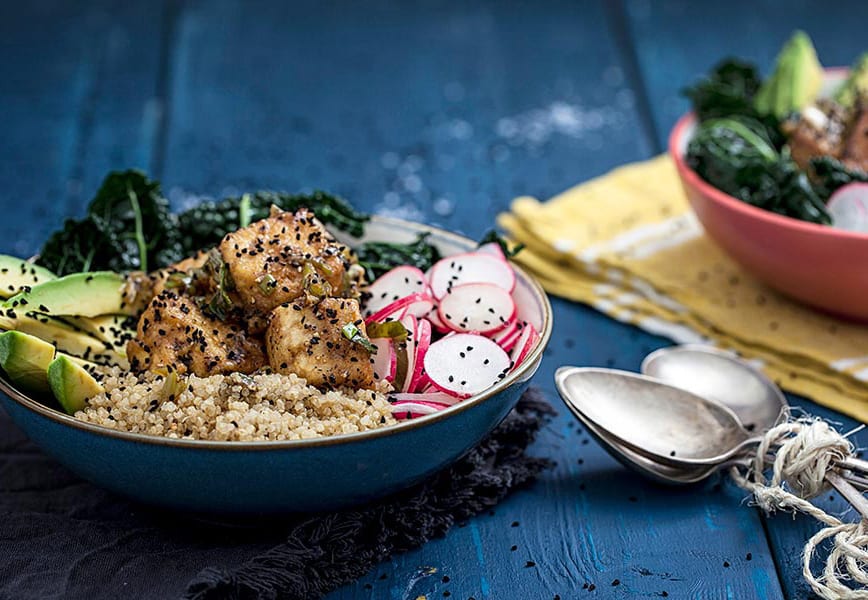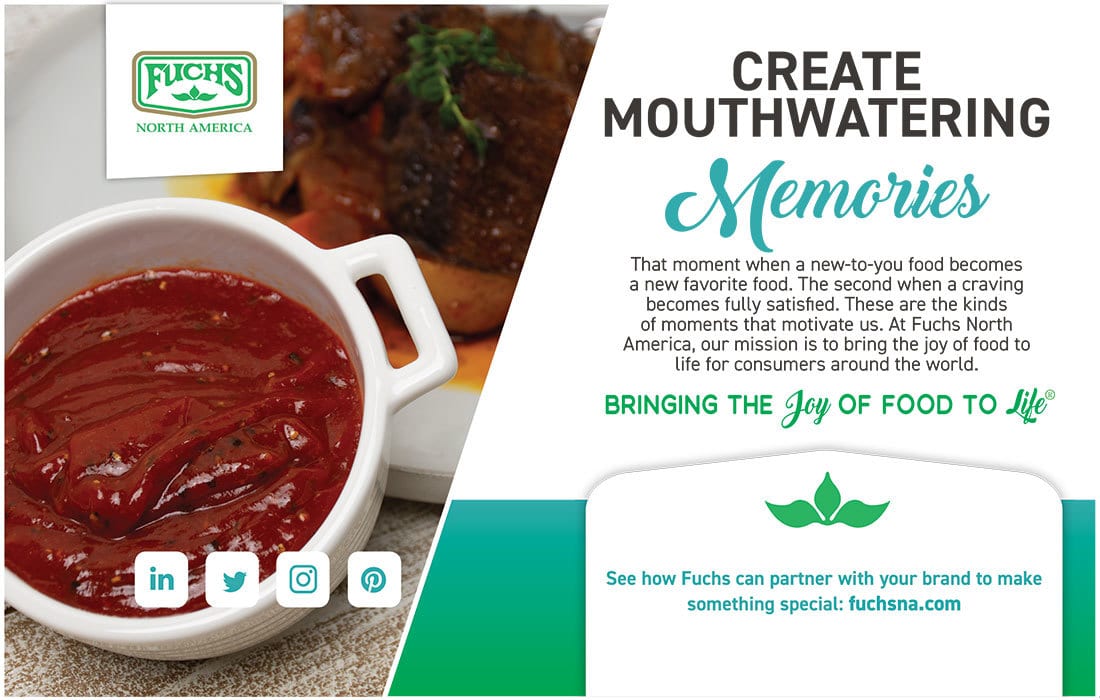2022
Predictions
FLAVORS
For centuries, cooks have artfully cross-pollinated cultural elements of flavor, and now culinologists are combining Latin, Asian, African, and other global ingredients and cooking techniques to launch innovative and flavorful prepared foods. Today’s retail shelves display a world atlas of culturally inspired experiences that might not be authentic yet answer the consumers’ desires to nourish themselves with fresh new takes on flavorful foods that simply taste good.
Fusion is not confusion; it’s part of a timeless evolution of people, places, techniques, ingredients, tools, and rituals revolving around flavor. To successfully bring new fusion foods to market requires both R&D creativity and contextual research to develop flavors and product profiles. Doing so can help meet increasingly sophisticated consumer expectations of inclusivity and cultural connection.
Just as grilling is a universal technique, similar elements, and ingredients can be found in the kitchens of Latin America, Southeast Asia, South Asia, Africa, Europe, and the Middle East. Hot chili peppers, for example, can be found in equally hot climes from Southeast Asia to Africa, and from India to Mexico. Other ingredients pop up in surprisingly dissimilar locations, such as cilantro in dishes of Mexico and Vietnam, or fennel seeds in favorite specialities in both Italy and the Middle East.
Ethnic and global flavors are still trending high—and so are cross-cultural flavor fusions.
Flavor Crossroads

Some currently trendy flavor combos, such as Egyptian koshari —pasta with lentils and spices—are classic cross-cultural fusions. Photo courtesy of: American Egg Board
By ROBERT DANHI, Contributing Culinary Editor, and DAVID FEDER, Executive Editor-Technical
A Chili Future
Looking into the next successful ingredient crossover invites the question, What will be the next chili sauce to go big? Taking a clue from food industry buzz, new menu items, and new product launches, the compass needle points to sambal chili paste from Malaysian, Singaporean, and Indonesian cuisines.
While sriracha—the ubiquitous fiery garlic and red chili sauce from Thailand and Vietnam—remains a favorite, product developers are beginning to realize sambal’s untapped potential. In addition to the peppers, shallots and garlic are relied on as affordable components that add sweetness and depth of flavor, and some versions include aromatic notes from lime juice or leaves, and even the bright accent of sweet-and-sour tamarind.
Some sambal versions are pounded, others are a puréed cooked mixture, and some are raw. The sauce is inherently vegetarian, although some variations have included fermented shrimp paste for an undercurrent of umami richness and depth. Sambal olek, one of the most basic varieties (combining chili peppers, garlic, and salt), already has become a product development staple yet is usually an anonymous flavor player. This versatile chili condiment is just getting started and is sure to become a more mainstream ingredient leveraged in new products.
Fusions do not necessarily have to be labeled as such—there are products that fuse cultures and flavors without “announcing” it. A stroll through one of today’s ubiquitous specialty supermarkets reveals prepared items ranging from Thai turkey and Korean bulgoki burgers, to banh mi pizzas and ramen burritos, to mac-'n'-cheese quesadillas and “everything but the bagel” seasonings in, well, everything but bagels.
Flavor blending
The global ingredient trade that brought citrus to the New World half a millennium ago worked both ways, of course. Chili peppers, a New World native, are now ubiquitous in Southeast and South Asian cuisines. Even foods as “all-American” dishes like a classic Texas barbecue brisket, simply rubbed with black pepper and salt, can’t escape flavors rooted in Mexican barbacoa or the key Piper nigrum ingredient from India.
Developing and successfully introducing new flavor blends successfully in the current market requires flexibility and creativity to meet consumer expectations. This applies not only to flavor and complexity, but also to providing broad, intercultural appeal without narrowly profiled cuisine labels. When anticipating consumer expectations for both culinary comfort zones and flavor, simply mashing together two culinary components to describe a new cross-cultural product doesn’t do it.
Today’s flavor fusion evolution is impacted by modern consumers’ hypersensitivity to cultural language and how that attracts or discourages identifying with the food product. This can create barriers based on flavor expectations, cultural appropriation, and previous culinary experiences. Certain flavors can have associated identities that lead, confirm, or confuse consumer expectations.

Today’s popular creative flavor excursions artfully combine Old World and New World ingredients and techniques. Photo courtesy of: Mizkan Americas, Inc.
For example, the kaffir lime (the juice, peel, and especially the leaf) is a signature ingredient of Southeast Asia. Also called a magrut lime, to the American palate it most often will be a flavorful cue of Southeast Asia and, more specifically, Thai cuisine. Although most singular in its powerful floral fragrance, it is a reminder that the limes that today figure so prominently in Latin and Caribbean cuisines originally were native to Asia.
Coming in hot
Informed by current trends, the number of American consumers aware of North African flavors is growing at a quick pace. This awareness is likely owed to the signature condiment of North Africa, harissa. The spicy crimson chili, garlic, herb, and caraway paste has been popping up in prepared foods such as Luvo Inc.’s Luvo Bowl Chicken Harissa & Chickpeas meal and Nestlé SA’s Lean Cuisine brand Sweet & Spicy Harissa Meatballs. The latter is not only an example of the popularity of the condiment, but the product’s flavor-fusion addition of sweet notes also plays to the US palate preference for sweet-and-spicy items.
The “B” in F&B
It’s time to invite Asian chili sauces to the party to play a flavorful role in beverage recipes and formulations. According to the research group Datassential, there’s been a recent rise in spicy beverages, such as Micheladas. A spoonful of sambal or gochujang, with their sweet-and-savory heat, is a surefire way (pun intended…and apologized for) to increase the flavor and the depth of red color in an “extreme” Bloody Mary. Considering a broader range of culturally contextual ingredients or sauces can easily expand options in established beverage products that could benefit from a surprise visit from another land.
Another product examplifying the interest in North African flavors is Amore Cucina, Inc.’s Kitchen & Love brand Cauliflower Quick Meal. Leveraging the recent healthy obsession with cauliflower, the base for this ready-to-eat pouch meal is cauliflower mashed together with harissa. But the company has been flexing its flavor trend muscles in other directions as well, biting into the latest Latin trend of South American flavors via its Peruvian Vegetable Ceviche and Artichoke & Roasted Peppers Quinoa.
Successful creation and marketing of new flavor fusions will continue to deliver on today’s consumer expectations for the exotic and exciting. Employing a culinologist's approach makes it possible to bring complex flavor concepts to market in a culturally inclusive, yet cost effective way. In this manner, it's possible to more successfully create flavorful products that defy, and surpass, any expectations based on the culture of the ingredients or that of the consumer.
Although the product development process leverages research technologies to examine myriad iterations on the way to market, answers to consumer expectations or desires don’t always reside in data plotted on a spreadsheet. Launching daring cross-cultural flavor combinations also benefits from systematic analysis of the non-verbal reactions, casual comments, and family stories shared in the taster’s experience of consuming, reflecting on, and enjoying the product. From these sources, rich with meaning, product developers can uncover the hidden food connections that consumers reach for across the flavorful global table. PF
Research chef Robert Danhi is an award-winning author and TV host. The co-founder of Flavor360 Solutions, he is an in-demand consultant to the F&B industry, maximizing the Flavor360 software platform for innovation, new product development, and operations excellence, all designed to save time and improve data quality at every stage of the R&D process. Chef Danhi can be reached via www.flavor360software.com.
December 2021

